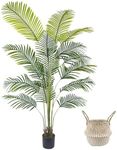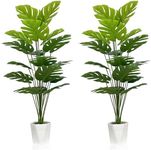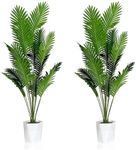Buying Guide for the Best Artificial Plants
Choosing artificial plants can be a fun way to add greenery to your space without the need for ongoing care. The right artificial plant can brighten up a room, add a touch of nature, and even improve the overall atmosphere. When shopping for artificial plants, it's important to consider where you want to place them, how realistic you want them to look, and how much maintenance (like dusting) you're willing to do. Understanding the key features will help you pick a plant that fits your style and needs.Material QualityMaterial quality refers to what the artificial plant is made from, such as plastic, silk, or polyester. This is important because it affects how realistic the plant looks and how long it will last. Higher-quality materials like silk or premium plastics tend to look more lifelike and are more durable, while cheaper plastics may look shiny or fake. If you want a plant that closely mimics the real thing, look for those made with high-quality materials. If realism is less important, or if the plant will be placed in a spot where it won’t be closely examined, lower-quality materials may suffice.
Size and ProportionSize and proportion refer to the height, width, and overall scale of the artificial plant. This matters because you want the plant to fit well in your chosen space without overwhelming it or looking too small. Artificial plants come in a range of sizes, from tiny desk succulents to large floor-standing trees. For small shelves or desks, choose compact plants. For corners or larger rooms, taller or fuller plants work better. Think about where you want to place the plant and measure the space to ensure a good fit.
Realism and DetailingRealism and detailing describe how closely the artificial plant resembles a real one, including the color, texture, and shape of the leaves and stems. This is important if you want your plant to blend in naturally with real plants or to fool the eye. Some artificial plants have hand-painted details, varied leaf shapes, and even natural-looking imperfections. If you care about authenticity, look for plants with detailed leaves, realistic coloring, and natural-looking stems. If you just want a pop of green and don’t mind a more stylized look, less detailed options are fine.
Pot and BaseThe pot and base refer to the container that holds the artificial plant. This is important for stability and style. Some artificial plants come in decorative pots, while others come in plain plastic bases meant to be placed inside your own pot. If you want a ready-to-display plant, look for one with a pot that matches your decor. If you prefer to customize, choose a plant with a simple base and place it in a pot of your choice. Make sure the base is heavy enough to keep the plant upright, especially for taller plants.
Maintenance and CleaningMaintenance and cleaning refer to how easy it is to keep the artificial plant looking good over time. While artificial plants don’t need water or sunlight, they do collect dust and may need occasional cleaning. Some materials are easier to wipe clean than others. If you want a low-maintenance option, look for plants with smooth leaves and simple shapes that are easy to dust. If you don’t mind a bit more upkeep, more detailed or textured plants can look more realistic but may require more frequent cleaning.
UV ResistanceUV resistance means the plant is treated to withstand sunlight without fading or becoming brittle. This is important if you plan to place your artificial plant in a sunny spot or outdoors. Non-UV-resistant plants may lose their color or deteriorate quickly in direct sunlight. If your plant will be in a bright or outdoor area, look for UV-resistant options. For indoor plants kept away from windows, this feature is less critical.














